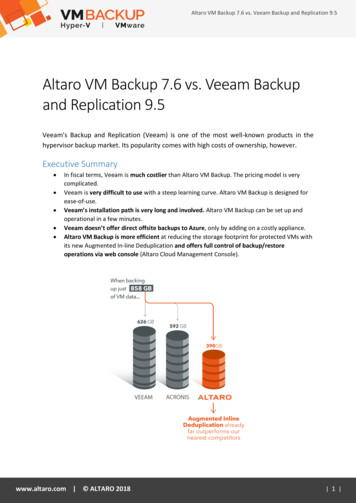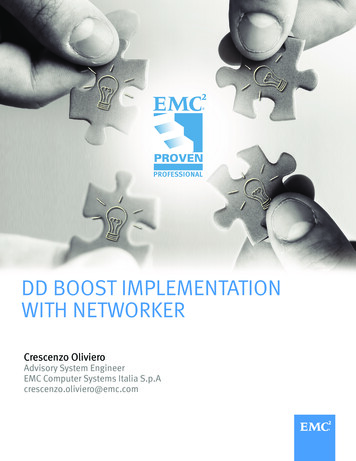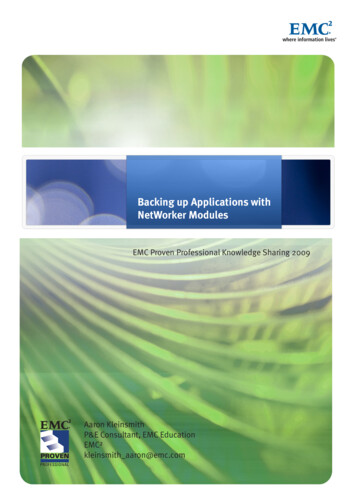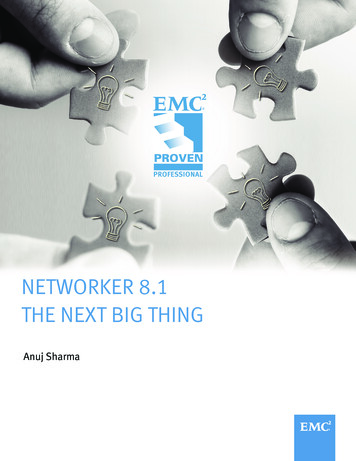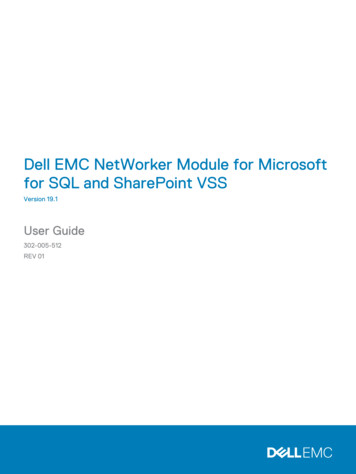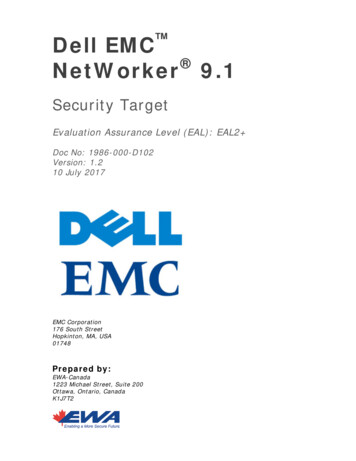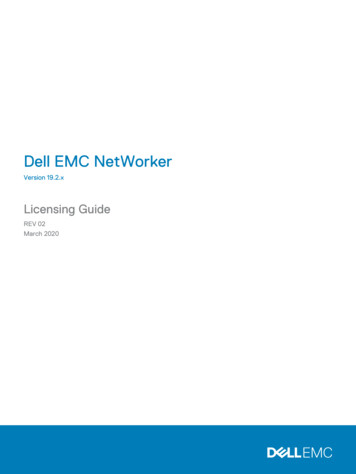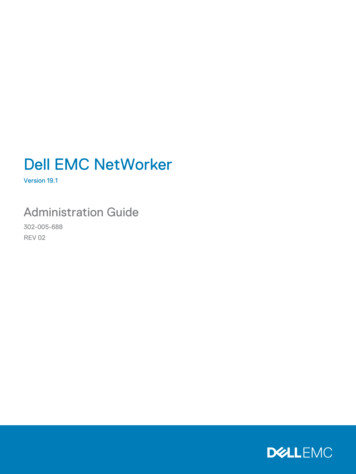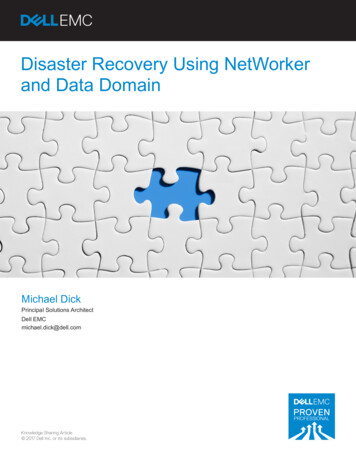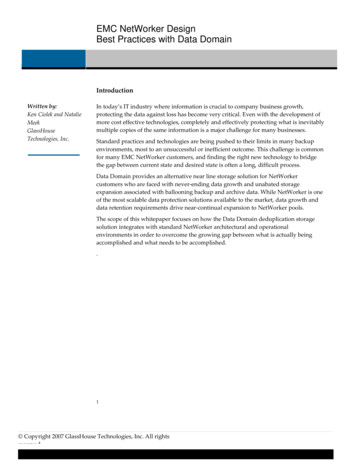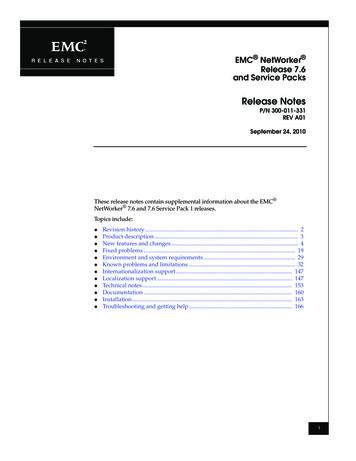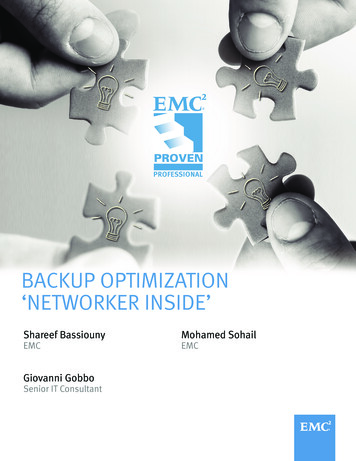
Transcription
BACKUP OPTIMIZATION‘NETWORKER INSIDE’Shareef BassiounyEMCGiovanni GobboSenior IT ConsultantMohamed SohailEMC
Table of ContentsExecutive summary . 3Introduction . 4Part 1 . 5How much Data Storage could be gained? How could it be maximized? . 7What is the penalty of this gain? . 8Classic design example . 8Advantages/disadvantages of the new DD Boost over Fibre Channel (DFC) .15Part II .16Journey to an optimized backup environment .16The Journey .18Steps to the solution .23NetWorker .23Data Domain .25Avamar .29“Virtualized Environments”.31Appendix .34Biography.35Disclaimer: The views, processes, or methodologies published in this article are those of theauthors. They do not necessarily reflect EMC Corporation’s views, processes, ormethodologies.2014 EMC Proven Professional Knowledge Sharing2
Executive summaryDo you need to speed up your back up by up to 50%? Do you need to reduce the use of yourbandwidth up to 99%? Do you want to reduce the backup server workload up to 40%? Do youwant to increase your backup success rate?The answer? Data Domain Boost (DD Boost) which enables you to finish backups withinbackup windows and provide breathing room for data growth. With performance up to 31 TB/hr,it is 3 times faster than any other solution, enabling you to use your existing networkinfrastructure more efficiently.In this Knowledge Sharing article we illustrate how we optimized our backup processes andleveraged current resources by integrating NetWorker backup management software and thenew DD Boost over Fiber Channel feature to enhance backup system performance.The major component of EMC backup and recovery software solutions, NetWorker is acornerstone element in the backup solutions of large infrastructure customers. This article targetsbackup administrators, support engineers, and stakeholders interested in the importance of theDD Boost over Fiber Channel feature and how to use it to enhance backup success rate. Thegoal of this article is to help you: speed up backups avoid congestion that slows down large critical backups through bandwidth utilizationreduction minimize workloads on backup hosts (NetWorker server and Storage nodes)2014 EMC Proven Professional Knowledge Sharing3
IntroductionIn Part 1, we follow a dialogue we had with a customer while promoting Data Domain for hisbackup environment, which led us to promote NetWorker as one of the best integrated productswith Data Domain appliances. Part 1 is a series of questions and answers that try to discoverwhy and how, while we were trying to concentrate on the basic concepts and leave the details tothe referenced documents, primarily “NetWorker and Data Domain Devices Integration Guide”version 8.1.Part 2 is the final output of the customer conversation from part 1 coupled with the data that wehad from the customer requirements documents. We then produced a solution proposal thatrelied on the concepts we had built in Part 1, along with details on how those products fit intothe customer environment.2014 EMC Proven Professional Knowledge Sharing4
Part 1While deduplicated storage as a backup media target is not a new concept in Backup andRecovery Solutions architecture (BRSa), the technology used for this deduplicated storage isone of the major factors that affects backup performance and success rates.A well-known example is EMC DL3D which integrated multiple storage technologies to achieveBackup to Disk (B2D) performance through a Virtual Tape Library interface, coupled with abackend storage deduplication. However, since the deduplication process was running offline,appliance performance was known to deteriorate beyond 70-80% disk utilization.Data Domain emerged as cutting-edge technology for deduplicated storage solutions targetingbackup solutions as a backup to disk storage. Its “in-line” deduplication technology (data isdeduplicated before being written to disk, as soon as it reached the storage host), and highperformance made it one of the best-selling products in the EMC Data Protection andAvailability Delivery portfolio. Perhaps the main reason for its market appeal is the sustainableperformance that it delivers (minimal performance degradation beyond 95% utilization) and thediverse storage connectivity options it provided. Further integration with backup solutions led toDD Boost, one of the most interesting features provided with Data Domain appliances.DD Boost is comprised of Distributed Segment Processing (DSP) coupled with DD API. DSP isa mechanism that enables client-side deduplication to be integrated into virtually any applicationthat wants to dump data to a secondary storage backup media. DD API is the Data Domainprogramming interface that enables applications/hosts to communicate with DD Operatingsystem (DDOS) in a way that leverages this integration interface to provide more features andfacilities to “boost” performance, minimize backup widow and bandwidth utilization, andenhance backup success rates.Basic concepts mentioned in the following discussion include:Brief Blueprint on Deduplication TechnologiesDeduplication and compression have the same aim; to remove redundancies from the datapatterns. While compression scope is file or an archive of files, deduplication scope is a FileSystem used to store backup data, also called Storage Unit (SU) in Data Domain jargon. Here,we are not talking about file level deduplication (which hashes the contents of every file on thefile system and thus detects duplicate content and removes the duplicate copies, replacing themby stub-pointers to the original content).2014 EMC Proven Professional Knowledge Sharing5
Figure 1: File-based deduplicationWe are talking about sub-file deduplication technology which segments every file using a certainsegmentation algorithm—the most efficient have been found to be variable lengthsegmentation—into chunks. It is those chunks that are identified by their hash fingerprints, so ifa duplicate chunk is found it is replaced by a pointer to the original chunk (the first one found tobe unique). This is the technology used for Data Domain deduplication, taking into account thatan added layer of compression is applied after new/unique chunks are identified.2014 EMC Proven Professional Knowledge Sharing6
Figure 2: Sub-file, variable length chunks deduplicationHow much Data Storage could be gained? How could it be maximized?While deduplication efficiency varies according to different factors, 20x disk spacereductions is typical for plain uncompressed file systems data. The main factors thataffect deduplication efficiency include: Data type or nature; some types of data are much more compressible (text files,spreadsheets, etc.) versus other types that are already compressed in nature(Audio/Video files, graphics) and thus recompressing them will not produce asignificant benefit. As it relies on file segmentation and file-chunks identification,any change applied on those incoming files (such as compression and/orencryption) will produce new patterns of chunks—even with minor changes onthose files—and thus reduce the gain from the deduplication operation. Change rate: Storage savings increase with each subsequent backup of thesave set because a deduplication backup writes to disk only those data blocksunique to its catalogue; thus, data that have a high change rate will producelower gain than data that has a lower change rate.2014 EMC Proven Professional Knowledge Sharing7
Data Retention: The amount of time data is intended to be kept available forrecovery affects the size of the data catalogue (imagine that there is a databaseof hashes that represent every stored chunk). As such, if you retain the data forlonger period, your catalogue is larger and thus your deduplication efficiencywould increase (as there will be higher probability to find similar chunks).For more information, check page 27 of “NetWorker and Data Domain DevicesIntegration Guide”What is the penalty of this gain?While not really a penalty, as with any compression algorithm, uncompressing(rehydrating) the data consumes time and effort. However, the DD appliance isengineered to make data rehydration as painless as possible. With DD Boost devices,concurrent sessions per device may extend up to 60 sessions per DD Boost device(multiple recoveries will not impair each other, nor will any application supporting parallelrecovery); each session can easily reach 50 MB/s in a good network infrastructuresupporting Gigabit Ethernet. Backup performance becomes very high following the firstfull backup (how high depends on the change rate), but recovery performance will becomparable to the performance of the first full backup because the data will be rebuilt inits plain format, then sent to the recovering host.Classic design exampleWhen configuring an environment for Backup to Disk, there are many alternatives in the choiceof the type of target media (local disk, SAN connected, or even NAS attached).One could settle for the simplest way and export a NAS (Network Attached Storage) file system(CIFS or NFS as per your client platform preference) to enable a backup to disk target filesystem that could be mounted on a backup Server, any of its Storage Nodes (SNs), or even aDedicated SN (a client application host that is used as a SN only for its own data; this aims tooptimize LAN access by setting the Application host as a "dedicated" Storage Node (DSN).Thus, the data goes from the application host to the backup storage directly instead of having topass by some generic storage node. This is an optimization configuration that avoids having thebackup data flow (client to SN and then SN to NAS appliance) traverse the LAN twice. It isneeded when the network access is a bottleneck.2014 EMC Proven Professional Knowledge Sharing8
A Data Domain host can be configured to export a NAS filesystem. Once your target disk isready, configure your disk device. In NetWorker AFTD is the type most used.Even without backup software, this NAS file system can still be used as a target for OracleRMAN backup script or MSSQL backup script, and Data Domain host will deduplicate theresulting backup files. Meanwhile, DD Boost demonstrates its value-add will by discovering thatbackup performance is limited by the network bandwidth.To tackle network congestion at the target Data Domain host, the Data Domain appliance isconfigurable for NIC aggregation for Network connectivity optimization. Network connectivityoptimization through link aggregation on Data Domain host side will certainly help. Still, evenwith link aggregation deployed without any problems, there are physical limitations to any LANthat it cannot bypass.Different aggregation protocols and hashing methods exist in the Data Domain configurationoption. It is important to mention that Link aggregation is a point-to-point mechanism, not endto-end. In other words, it aggregates the switch ports to Data Domain NICs into a single virtualinterface, but the clients are not aware of this mechanism. Details are available in the DataDomain OS administration guide.If you do not favor backup to disk for any reason, i.e. it saturates your LAN links or causes LANinfrastructure constraint, you can use your hosts SAN connectivity to connect to the DD virtualtape library (VTL). This allows data to travel on the SAN through Fiber Channel (FC)connectivity without any data transport overhead on the LAN, which is still used in this case butjust for meta-data transport to the backup server.What if the above options are not enough? What if we have a tighter backup window andneed more optimizations?DD Boost is the answer. As the size of data targeting the Data Domain host—sent over the wireas plain data—scales up, duties increase for your LAN and pressures rise on your backupsystem especially with more backup-to-disk clients and storage nodes added in your datacenter.In such situations, client-side deduplication or, in Data Domain parlance, Distributed SegmentProcessing is your solution, as it enables identification of file chunks to take place on thededuplication client side (the host that sends data to the Data Domain appliance). Thus, there is2014 EMC Proven Professional Knowledge Sharing9
no need to send all plain data on the network; only new chunks need to be sent to the DataDomain host.In other words, DD Boost with its DSP feature working through Data Domain API ensures thatthe host that is sending data to the Data Domain appliance is not sending redundant data overthe network. Any DD Boost-enabled application will compute the hashes of the chunks of datathat it wants to send to the Data Domain host for storage, then ask the Data Domain host : doyou already have those fingerprints (as an identifier for each file chunk) in your catalogue? If so,the Data Domain host does not need to receive redundant data; it will just create the pointer. Ifnot (this is a new data chunk) it is compressed, then sent to the Data Domain host for storage.Figure 3In this way, data redundancy checking becomes a mutual effort between the deduplication client(host sending data using DD Boost functionality) and the Data Domain host appliance, whichoptimizes the network usage in exchange for a minimal CPU and memory penalty on the clientside.Projecting the above concept on to NetWorker operations, we can see that all that is needed isto transform NetWorker Backup to disk devices to be DD Boost-enabled. Thus, we do not haveto worry about which NAS protocol to use for network file access (DD Boost handles that partthrough its native NFS). Even device directory creation is managed through DD Boost asNetWorker can do that through talking directly to Data Domain OS through the DD Boost API.Details on DD Boost device creation are found in the “NetWorker and Data Domain DevicesIntegration Guide”. Also, migration from Old Tape devices / Backup to Disk devices to DDBoost-optimized devices is discussed in Chapter 3 of the same document.2014 EMC Proven Professional Knowledge Sharing10
The bandwidth and time gain is quite astonishing, as NetWorker adds more usages of the DDBoost API “client direct” configuration option (added in NetWorker 8.0) enabling backup clientsto send their data “directly” to the Data Domain host instead of having to pass by theirconfigured Storage Node. This optimizes network usage and accelerates backup execution asnow the clients are not sending any plain data to their SNs on the wire. Though the SN is stillused for meta-data processing, it is not stressed with the data storage efforts which increasesthe likelihood for backup success.Figure 4This is not the only gain from buying DD Boost, but this is how we choose to introduce anexample on its utility. Two great gains arise from the fact that the backup application can talk toData Domain OS and see the deduplication catalogue:1. Clone Controlled Replication2. Virtual Synthetic FullHow does DD Boost enhance cloning? Does that include cloning to all type of media?Cloning is copying a saveset from one storage media to another. A common example is cloningsavesets from disk devices to tape devices for long term retention. Thus, the cloning operation2014 EMC Proven Professional Knowledge Sharing11
includes reading the saveset (similar to recovering it) then writing it back to another media(similar to backup).The scope of DD Boost cloning is not related to storage media other than Data Domain, whichmeans if you are cloning your savesets between storage media that includes anything otherthan Data Domain hosts, you will be running conventional cloning (recover the saveset frommedia A write it to media B). However, if you are cloning your saveset between two DataDomain hosts, this is your chance to leverage DD Boost Clone Controlled Replication (CCR).Figure 5How does it work?When both source and target storage pools are Data Domain devices, DD Boost saves backupsystem bandwidth, i.e. CPU, memory, and network bandwidth, through the Managed FileReplication (MFR) feature. How this happens is an interesting story; as the cloning operationreads the saveset that it wants to clone from DD Boost device A on DD host A (like recovering),it should then write it to DD Boost device B on Data Domain host B as this saveset is stored inthe form of a file (or more). Why not tell Data Domain host A to replicate that file to Data Domainhost B? This would save the effort of reading (which is a rehydration operation) the whole fileand writing it back (which is a dehydration operation) to a different host. Also, bandwidth that willbe utilized to read the plain data saveset can also be preserved, because Data Domain2014 EMC Proven Professional Knowledge Sharing12
replication copies only the chunks missing (to construct that file) from source to destination. Thismakes CCR a great candidate for cloning to the Disaster Recovery (DR) site, satisfyinglegislative requirements to archive your backups offsite for financial auditing, corporate internalauditing requirements, DR planning, and contingencies without the need to clone to tape.Figure 6What advantage does CCR have over the conventional Data Domain replication?Quite a few. Data Domain conventional replication has three limitations:1. The backup server will not be aware that cloning took place, so manual intervention willbe needed to create and mount the required device, if recovery from DR is needed.2. You should not use conventional cloning with DD Boost devices (the replicated devicescannot be used as a source for further replication). For more information, see DataDomain native replication considerations of “NetWorker and Data Domain DevicesIntegration Guide”3. There is no way to force different retention on cloned savesets as the backup server isnot aware of replication. Consequently, this cannot be used for long term archiving.2014 EMC Proven Professional Knowledge Sharing13
Any other cloning enhancements?It is important to mention that NetWorker 8.1 added a new enhancement to a cloning operationcalled “immediate cloning”. This enables a saveset to be cloned as soon as its backup is done,as opposed to group cloning that runs a clone process to
RMAN backup script or MSSQL backup script, and Data Domain host will deduplicate the resulting backup files. Meanwhile, DD Boost demonstrates its value-add will by discovering that backup performance is limited by the network bandwidth. To tackle network congestion at
